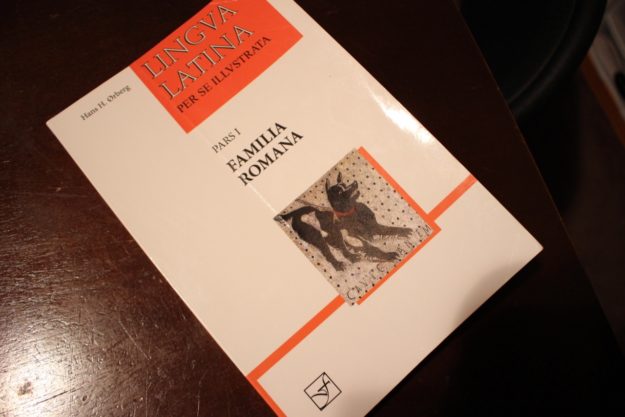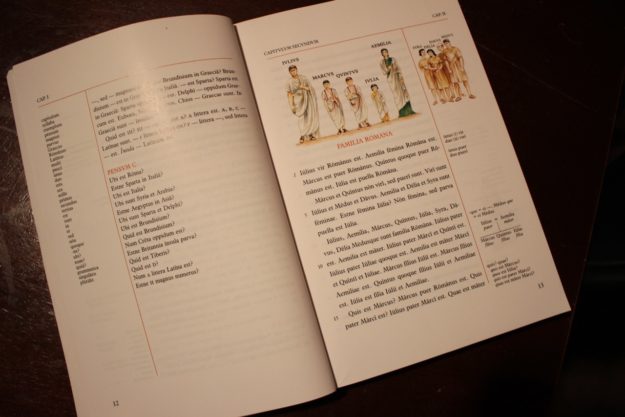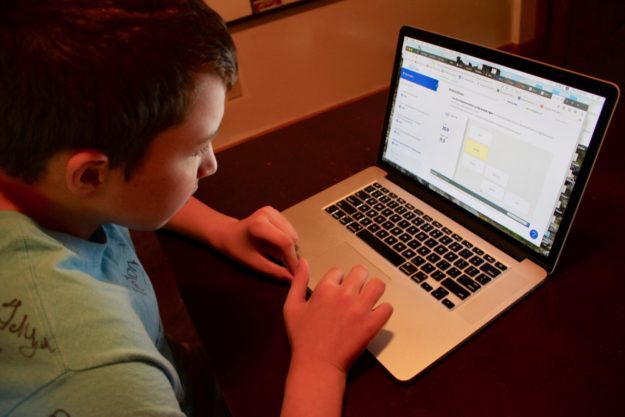Latin. It’s a subject I didn’t really buy into when we first started homeschooling. When we entered into a classical co-op, it’s the subject we often ignored. I didn’t find value in it, so we dropped even the small amount of Latin memory work from our schedule. I was certainly a skeptic with no desire to pursue studying this ancient language.
Fast forward 8 or 9 years, and now it’s an essential part of our educational goals as a family. Why? What changed? Why has it become significant?
As with most things regarding our homeschooling journey, our Latin story begins with our firstborn. Our oldest has been studying Latin for over five years now. It hasn’t been easy. We’ve had to adjust our way forward to avoid giving up. We’ve had to re-examine and re-set our overall goals for studying Latin. But although it hasn’t been a perfect path, I’ve seen the fruit of working through this challenging subject. <— If you’d like to know more about the benefits of Latin, let us know in the comments!)
A Goal for Learning Latin
For a long time we’ve wrestled with what our true goal should be for studying Latin long-term.
- Are we just using it as a foundation for other foreign languages or an exposure to vocabulary for college prep testing in the future?
- Are we using it as an exercise to shape the mind and better understand (and communicate in) English?
- Is our ultimate goal to read the words of Caesar, Cicero, or Virgil? And why would it be important to read those words in their original language instead of an English translation?
Our original ultimate goal for learning Latin was to be able to read Henle Second (and Third and Fourth) Year Latin because these were built upon a study of classic speeches and writings from antiquity. But after flipping through these books, I realized I was requiring something of my children that I was unwilling to do myself. Let me tell you, though, I’ve wrestled with the decision to break away from the goal of reading the Henle Second Year Latin text, simply because it’s what my mind was set on for several years. But if I was dreading teaching it myself, we needed a new goal.
Top Reasons for Choosing Visual Latin
Our children enjoy it. When you need to learn a difficult subject, there’s no sense in making the subject even more difficult by presenting it in a foreboding and difficult format. Visual Latin not only includes solid instruction, but it also includes comic relief, which is a welcome break in the study of a difficult subject.
Dwane Thomas provides examples that are memorable and engaging. In fact, every single one of our children gravitate towards the computer or television when Visual Latin is playing. They laugh and enjoy themselves while learning Latin. In fact, when I led a 3-day seminar themed around Latin last year, this is the program I used to prepare. (And did you know humor is a great memory aid?)
It’s organized in a way that makes sense. For example, verbs are introduced first. In order for a sentence to be a sentence, there must be a verb. By introducing some basic verb concepts first, Visual Latin paves the way for learning sentence structure right away. And concepts continue to be introduced in a logical progression that makes sense to our family.
Lessons are clear, concise, and focused. Lessons don’t take 2-3 hours per day. Our middle schooler spends 45 minutes on Latin each day. Our upper elementary student spends about 20 minutes each day. And they actually remember and understand what they’re learning.
Visual Latin focuses on fluency from the very beginning. Visual Latin incorporates readings that students hear and repeat. Approximately midway through Visual Latin 1, students can start incorporating the book Lingua Latina, which is entirely written in Latin with contextual clues for translation. (We recommend using this extra resource in conjunction with this Lingua Latina Companion.)
Most students become fluent in a foreign language through immersion. Latin’s downside is that it is not a spoken language except within certain church settings. Visual Latin provides opportunities for students to be immersed in the language itself so they can use that same process, even with an ancient language that is no longer spoken. (By the way, I’ve seen our oldest son pick up Lingua Latina and read it in his spare time. Reading Latin during leisure time? I never thought that would actually really happen! It has me wondering… could Visual Latin be a Suzuki method of learning Latin?)
Students learn to read Latin fairly fluently within two years. I say this with reservations because our family has not yet completed Visual Latin. But as I look at Visual Latin 1 & 2 set before me, I can see how a two-year program can lead to fluency. As with learning any language, fluency does not mean total mastery. After all, I’ve not mastered all of English even though I’ve spoken and written English for 40+ years. There are still thousands of words I don’t know. But what do I do when I come across something I haven’t seen before? I look it up. That’s what students are taught with Visual Latin. They learn to read fluently (translating automatically), and when they come across words they don’t understand, they look them up in a Latin-English dictionary.
It provides a foundation in Latin before proceeding with a foreign language. Our family’s goal is to provide a solid foundation in Latin in the middle school years so that in high school we can proceed with either advanced classical studies in Latin/Greek or a foreign language. As a two year program, Visual Latin provides us with the opportunity to tackle Latin in middle school so that we have more flexibility in high school.
It’s biblically based. Every lesson includes readings from a simplified Vulgate Bible. This provides immensely better content than reading about dead bodies floating in rivers. (Thank you, Henle, for providing us with perspective.)
It has a follow-up program to learn Spanish! Dwane Thomas now offers a Spanish Grammar from Latin Roots course which we are completely over-the-top excited about! This is exactly the way we wanted to learn Latin: first Latin, and then another foreign language.
So those are the reasons we are now using Visual Latin as our core Latin program in middle school. But you don’t have to just take our word for it. You can check out the first four lessons for free at Compass Classroom to see if it’s a good fit for your family, too!
Visual Latin Lesson Layout
Visual Latin is a two-year, video-based Latin homeschool curriculum consisting of Visual Latin 1 (Lessons 1-30) and Visual Latin 2 (Lessons 31-60). Each lesson includes three ~10-minute videos covering grammar concepts…
practicing sentences…
…and reading in Latin.
After each video, students have a corresponding assignment practicing the grammar concept or translation exercise.
In the streaming version of the course, Quizlet vocabulary flashcards & games are also included in the lesson line-up. For students who have the download or DVD version, the Quizlet Visual Latin on-line vocabulary flashcards may be accessed online as well.
All of the course materials needed for Visual Latin are available in digital or printed format. The downloads include all materials for using Visual Latin:
- Teacher’s Guide with Scope & Sequence
- PDF Worksheets/Answers
- Weekly Quizzes/Answers
- Vocab Lists to Lesson 30
- Dwane’s Awesome Latin Lists
Take it for a test drive! You can work through the first four lessons for free at Compass Classroom. Then you can grab Visual Latin 1, Visual Latin 2, or the entire program over at Compass Classroom.
Foreign Language Credit?
If your state accepts Latin as a foreign language, Visual Latin provides two high school credits of foreign language. For a full 150 hours of work, parents can opt to include Lingua Latina instruction alongside the program using the free Visual Latin & Lingua Latina Teaching Guide that matches Lingua Latina to the program over a two-year period. Even though this course qualifies for high school foreign language credit, we’ve found that even our 10-year-old enjoys it (although he is completing lessons at a slower pace than our older children).
Need help with high school lesson planning? Check out our High School Lesson Plans: Truth Trek Series which provides lesson plans for Visual Latin and Lingua Latina! Lesson plans for Visual Latin 1 are included in our High School Lessons: Truth Trek One , which provides plans for a full year of study in science (Biology I), U.S. history, American literature/composition, foreign language, math, and electives (Bible, health, and government). (Visual Latin 2 is covered in High School Lessons: Truth Trek Two.)
Try it free, plus more!
You can not only work through the first four lessons for free at Compass Classroom, you can also test drive an entire library of courses with the Compass Classroom Premium Membership! This program is one of over 30 courses offered in Compass Classroom’s monthly membership which is now available as an app so you can take your learning on the go! You can sign up for one free week to try everything out, including the programs we have used and recommended in the past.
Be sure to sign up here to check out all the courses Compass Classroom offers! While you’re at it, you can also sign up for a free MyCompassClassroom account to experience discussion forums, support groups, and free courses!
Check out all of Compass Classroom’s free downloads here. And check out even more resources from around the Internet. Below are Latin resources available from Compass Classroom.
- Visual Latin & Lingua Latina Teaching Guide. A free two year Visual Latin-Lingua Latina Chart to guide you through the process of using both Visual Latin and Lingua Latina.
- Visual Latin & Henle Latin Teaching Guide. A free guide that matches up specific chapters and concepts to make it easier to use Visual Latin and Henle Latin.
- Dwane’s Awesome Latin Lists. This folder contains all of the Latin endings on four pages.
- Latin Readers. We compiled some of the great older Latin primers now in the public domain. Check back regularly since we will be adding more titles to this list when we find them.
- Cornelia – Read by Dwane Thomas. Visual Latin teacher Dwane Thomas reads the entire book of Cornelia one chapter at a time.
- Lord’s Prayer and Creeds in Latin. The Lord’s Prayer, The Nicene and Apostle’s Creed in MP3 audio versions. They are read by Dwane Thomas in the Ecclesiastical pronunciation.
- Visual Latin: 4 Free Lessons.
- Visual Latin – Other Free Resources: video helps, games, activities, and more
If you’re looking for a fun vocabulary program featuring Latin and Greek roots, be sure to check out Word Up! The Vocab Show. It’s another absolute favorite of our boys! You can download a free lesson from Word Up! here. You can also read our review of Word Up! here.
If you have any questions about this course or about the Compass Classroom Membership, just give us a shout! We’ll be glad to help in any way that we can!
You can also visit this helpful website which lays out how to plan your year using Compass Classroom.
This post includes affiliate links. When you purchase items through these links, it provides a commission which supports our family and keeps this website going. Affiliate links are used to support the cost of maintaining this website and support our small family-based business while allowing us to contribute to ministries around the world. Please read our full disclosure policy for more information.














